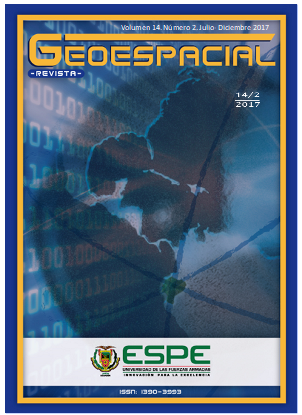CUANTIFICACIÓN Y MAPEO DE SEDIMENTO MOVILIZADO POR BARRIDO HIDRÁULICO EN EL MODELO FÍSICO A ESCALA REDUCIDA DEL PROYECTO HIDROELÉCTRICO NORMANDÍA (ECUADOR) MEDIANTE ESCÁNER LÁSER TERRESTRE.
Contenido principal del artículo
Resumen
Los sedimentos que se acumulan en los embalses reducen año tras año su capacidad de almacenamiento útil y pueden generar problemas en ciertas obras de las centrales hidroeléctricas (obras de toma, túneles, turbinas). Existen diferentes tipos de métodos para la retirada de sedimento de los embalases. Uno de los más efectivos y económicos es el barrido hidráulico por desagüe de fondo (flushing). La efectividad de este proceso puede predecirse mediante modelos matemáticos y también puede medirse mediante sensores en experimentos a escala real o en modelos físicos a escala reducida. En el año 2018 está previsto que se construya el proyecto hidroeléctrico Normandía en el río Upano, en la provincia Morona Santiago, Ecuador. En este trabajo se ha analizado mediante escáner láser terrestre y CloudCompare los efectos de una maniobra de barrido hidráulico de sedimento en el modelo físico a escala 1:60 del proyecto, ubicado en el laboratorio de Hidrofísica de suelos de la Universidad de Cuenca. El sedimento evacuado del embalse a escala ha sido el equivalente en la realidad a 408 volquetas de 18 m3. El efecto del barrido hidráulico ha sido mayor en la cola del embalse, ya que es el sector donde más sedimento se acumuló durante el azolvamiento. En las proximidades de la presa los incrementos del nivel de sedimento han sido mucho menores.
Detalles del artículo
Sección
Artículos Técnicos
Acceso a archivos
Los artículos publicados en la Revista Geoespacial se sujetan a las directrices de OPEN ACCES, en cuanto a la apertura de su contenido hacia todos los visitantes del sitio.
Derechos que conserva el autor:
El autor conserva los derechos morales de publicación
Cesión de derechos a autores:
Se cede los derechos de citas, referencias y temas relacionados con aspectos académicos y de investigación
Cómo citar
CUANTIFICACIÓN Y MAPEO DE SEDIMENTO MOVILIZADO POR BARRIDO HIDRÁULICO EN EL MODELO FÍSICO A ESCALA REDUCIDA DEL PROYECTO HIDROELÉCTRICO NORMANDÍA (ECUADOR) MEDIANTE ESCÁNER LÁSER TERRESTRE. (2020). Revista Geoespacial, 14(2), 67-82. https://journal.espe.edu.ec/ojs/index.php/revista-geoespacial/article/view/1600

